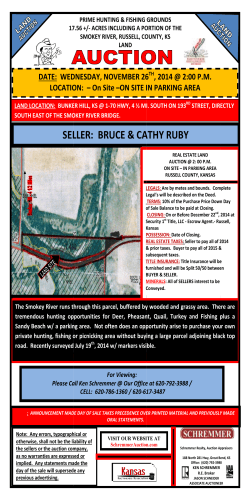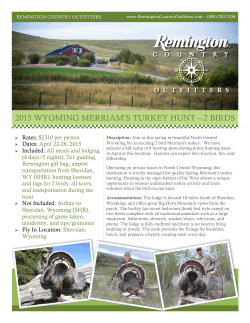
here - Nelson / Marlborough Region
Nelson/Marlborough Hunting – where to go? By Rhys Barrier With the explosion in lifestyle blocks and coastal development in the top of the south due to our benign climate and fantastic natural environment, the reality for many Nelson based game bird hunters these days is they head out of the region for opening weekend unless they are lucky enough to know a sympathetic private landowner with a decent mallard pond. Having said that, there are still limited public space opportunities within our region which can be worth investigation, if a long road trip is not an option for you. Fish & Game also currently run a hunter ballot system in Marlborough and are endeavouring to gain access to a range of potential future hunter ballot sites in Tasman where public hunting space opportunities are currently very thin on the ground. I will attempt to summarise public space hunting opportunities within our region below, noting the first port of call for any of these areas is to check out www.wams.org.nz. This site set up by the government appointed Walking Access Commission, is a fantastic starting point for sleuthing a local hunting spot. It has excellent resolution aerial imagery, topographic maps, property boundaries, and land title and status information, meaning you can work out the usual questions such as do I need to gain permission to cross private land to get to the site, how far away are the nearest houses etc. It also contains all our river access points for anglers, however any of these which cross private land, hunters are asked to please contact the land owner prior to using them, as landowner attitudes to hunting are often different to angling. Once you have sorted out access requirements for your chosen spot via WAMS, the next step is to visit the area (minus gun and dog!), well in advance of the game bird season and check out numbers of game birds within the area, and any adjacent tagged hides that were probably not visible on the WAMs system. Many of our public space areas are estuarine so bird use of these areas is very tide and wind dependent so more than one visit is often required to establish bird behaviour. Areas worth exploring within our region are summarised as follows: Golden Bay: An under-utilised game bird resource with some opportunities but homework is required before driving over the hill and expecting a good bag of birds. Hunters checked by compliance staff in this region often complain there are not enough hunters about to keep the birds moving within their patch on opening day. As with Tasman, a range of coastal development is slowly shrinking available public hunting space but a few opportunities still exist, notably the river mouth delta systems of both the Takaka and Aorere Rivers. A few of the smaller less developed estuaries are also still worth a look such as Wainui, Ruataniwha, and Pakawau Inlets, or for the really dedicated hunters the massive wild Westhaven Inlet, or Druggans Dam (difficult four wheel drive access). Nearly all these sites require boat access and good open water hunting experience. Department of Conservation in Takaka also administer a hunting permit system (negotiated by Fish & Game) for limited hunting times on lakes within the Puponga Farm Park, and provide permits for hunting on the Kaihoka Lakes, all of which can be reached on foot. Outside of these areas there remain river beds which sometimes have local duck camps on them that can produce good numbers of birds if hunted at the right time of the day. Again a lot of home work on WAMS and some prior visits are usually required. There also exist many small pothole lakes on private land in the Takaka Valley and oxbow/river backwater systems in the Aorere Valleys, so it doesn’t hurt to ask if you can track down the relevant landowner, chances are it will be no, but if you don’t ask you won’t know. Upland game hunting in Golden Bay is effectively limited just to quail on private land Nelson/Motueka: A far cry from former glory days when mallards ‘blackened the sky’ on their evening flight line from the Motueka estuary to pea growing areas in the district. There are still very limited public space opportunities available near the mouth of the Riwaka, Motueka, and Waimea River mouths however, and potential duck camp opportunities within the larger river beds. In the past hunters often floated the Motueka River for ‘jump shooting’ opportunities on mallards, but the river has so many houses near it these days this is probably too risky over much of its length now. The Motueka and Waimea bermlands are home to the last public land areas where pheasant can be hunted over the 3 pheasant weekends, but as with estuarine hunting, opportunities are reducing severely as the region develops more lifestyle blocks, cycle ways and the like. Reasonably expansive areas of quail hunting exist within forestry land if you are prepared to pay the costs of a forestry hunting access permit for these blocks, and sometimes occasional ponds or small creeks with grey/mallard duck also occur in these areas. The quail hunting can often be frustrating due to thick cover preventing follow up hunting after the first flush. Permission for private land hunting is hard to come by in these areas, although many landowners do experience problems with excessive pukeko numbers in Tasman so an offer to reduce the number of pukekoes for a landowner can sometimes result in future hunting access to one of the many water storage ponds in this region (e.g. Moutere) being granted. Pukeko hunting within a safe firing zone can be a great way to introduce a youngster to game bird jump shooting. An extended pukeko season exists in the Motueka/Nelson area with additional hunting opportunities from Aug 1st – Oct 31st, and then again from January 1stFebruary 28th. Pukeko are by far the most under-utilised game bird resource in this area, and contrary to popular belief are quite edible – substituting pukeko breast meat for hare in “Sardinian Hare Stew” (easily found on Google) will produce a very unusual tasty dish – even my fussy partner and kids eat this dish. Buller/Murchison/Maruia: good hunting opportunities can be found within the many riverbeds of this area, with both duck camps and jump shooting opportunities. The predominance of dairying means shelduck are often found feeding on new pasture so door knocking can be worthwhile also. Marlborough low country: The lowland areas of the Pelorus River and estuary, Wairau River bed, and Wairau Lagoons undoubtedly hold the largest areas of wide open space public land with reasonable game bird hunting opportunities still present within the top of the South Island. An access pamphlet for the Wairau Lagoons is available from either the Blenheim or Nelson Fish & Game Office for those new to the Wairau Lagoons. The Blenheim office also runs an annual hunter ballot for the first two weekends of the game season within the 100 hectare Para Wetland, after which time normal pegging rules apply. Resident Para Wetland mallards. Between the Wairau Lagoons, Wairau Riverbed, and Para Wetland there are many opportunities for hunters with a sense of adventure and plenty of time at their disposal. The Pelorus River and estuary offer both drift boat jump shooting and duck camp opportunities and the extensive Havelock Estuary is a popular waterfowl loafing area for those who like the challenge of open water decoying, but boat access is generally required, unlike some parts of the Wairau Lagoons. The Wairau Riverbed above the Waihopai offers miles of walking for jump shooting options and duck camp scouting, quail, rabbits and geese are also often encountered. Riverbed and estuary hunting later in the season offers low stress, solitude, great scenery, and sometimes a few birds to take home. Marlborough high country and Kaikoura: Kaikoura riverbeds such as the Clarence, Kahutara, Kowhai, and Hapuku offer quail hunting, a few shelduck, and the occasional mallard. Private land in South Marlborough including the Awatere catchment offer the best quail hunting in the region if access is able to be obtained. Currently most game bird hunting within Molesworth Station is undertaken during the annual winter goose hunts which are currently organised by the New Zealand Game Bird Hunters Association now geese are no longer classified as a game bird. Reasonable numbers of shelduck and a few mallards can be found on water bodies within the Molesworth Station during the winter shoot.
© Copyright 2025









